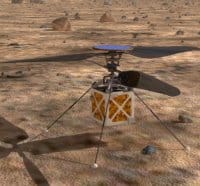Engineers at NASA’s Jet Propulsion Laboratory in Pasadena, California are developing a small solar powered helicopter to act as an added set of eyes for future Mars rover missions.
While Mars rovers have some rather whizz-bang camera technology, their field vision is limited. Spacecraft orbiting Mars can also help guide the planning of rover routes, but what’s really need are more eyes on the ground – well, closer to it anyway.
The Mars Helicopter could potentially triple the distance rovers currently cover in a Martian day, peering over obstacles and assisting mission control back on Earth plan the best driving route; plus spot potential exploration and sample collection opportunities.
Controlling a drone can be tricky on Earth, but on Mars it will be even more so. Aside from distance between operator and drone, Mars’ atmosphere is a hundred times thinner than that of Earth. Helicopters gain lift by rotor movement pushing against the density of the atmosphere. The heavier the helicopter, the bigger the blades needed – especially on Mars. As space is at a premium on any mission; there was another option – go lighter and smaller.
The box-like craft will likely weigh around 2.2 pounds (1 kilogram) and measure 3.6 feet (1.1 meters) between blade tips.
The blades of the Mars Helicopter will need to spin at about 2400 rpm to provide lift and the vehicle will be designed to fly for 2-3 minutes each day; enough to cover around half a kilometre.
In between flights, a solar panel situated on top of the rotor hub will recharge the batteries; which won’t just be used for flight, but also to help keep the helicopter warm in Mars’ frigid conditions.
Project engineers are working towards making the unit bullet-proof as it will need to endure landings each day on a surface that can be strewn with rocks.
The helicopter may be used in conjunction with NASA’s 2020 Mars rover mission. That rover’s design will be derived from the Curiosity rover. Unlike the Spirit and Opportunity* vehicles before it; which are/were solar powered (communication with Spirit was lost in 2010) , Curiosity is powered by a radioisotope thermoelectric generator (RTG).
*Opportunity mission update – Opportunity has driven 41.7 kilometers since it began operations on Mars on Jan. 25, 2004 The rover’s work on Mars was initially planned for just three months. A recent update on Opportunity’s wanderings can be viewed here.







































